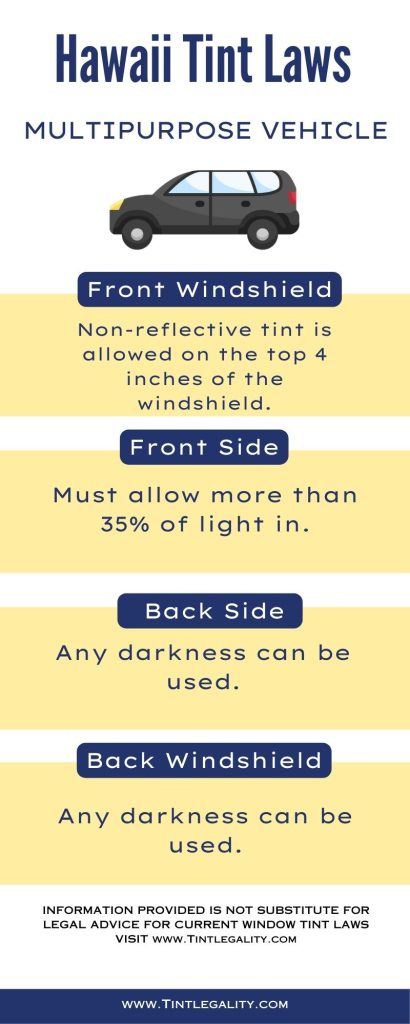If you’re living in Hawaii or planning to visit the state with your vehicle, you should know about the regulations regarding window tinting.
These laws were enacted in 1989 to ensure the safety of drivers, passengers, and pedestrians on the road.
In this article, we’ll discuss everything you need to know about Hawaii tint laws, including regulations, exemptions, penalties, and benefits.
Regulations Regarding Window Tint in Hawaii
The state of Hawaii has specific laws regulating the use of window tint on vehicles.
These laws are in place to ensure that drivers can see clearly while driving and to prevent accidents caused by poor visibility.
Here are the regulations you need to follow:
| Location | Tinting Limit |
|---|---|
| Front Windshield | AS-1 line only |
| Front Side Windows | 35% VLT minimum |
| Back Side Windows | No limit* |
| Rear Window | No limit* |
| Reflection | Not allowed |
| Medical Exemptions | Allowed |
| Color Restrictions | None |
| Side Mirrors | Required |
| Exceptions to Legal Limits | None |
Windshield
The front windshield of a car cannot have any tinting, except for a small strip at the top, known as the AS-1 line.
The AS-1 line should not be lower than 4 inches from the top of the windshield, or below the manufacturer’s original AS-1 line if it exists.
Front Side Windows
The front side windows, which are located on the driver and passenger sides, must allow at least 35% of visible light transmission (VLT).
This means that the tint should not be too dark, and at least 35% of the natural light should be able to pass through the windows.
Back Side Windows
The back side windows, which are located behind the driver and passenger seats, can have a tint of any darkness level, as long as the vehicle has side mirrors that provide a view behind the vehicle.
Rear Window
The rear window can also have any level of tinting, as long as the vehicle has side mirrors that provide a view behind the vehicle.


Additional Regulations
Reflection
The use of reflective tint is not allowed in Hawaii. This type of tint reflects light and can be a distraction to other drivers on the road.
Medical Exemptions
Drivers with medical conditions that require them to limit their exposure to sunlight can apply for a medical exemption to use a darker tint.
To get the exemption, the driver must provide a written statement from a licensed physician, stating the medical condition and the recommended level of tinting.
Color Restrictions
Hawaii law does not restrict the color of tinted windows, as long as they comply with the VLT requirements.
Side Mirrors
If the back side windows or rear window are tinted, the vehicle must have side mirrors that provide a view behind the vehicle.
Exceptions to Legal Limits
There are no exceptions to the legal limits for window tint in Hawaii. All vehicles must comply with the regulations.
Penalties for Breaking the Law
If you break the Hawaii tint laws, you may face penalties and fines. Here are the consequences of breaking the law:
Fines
The fines for breaking the window tint laws in Hawaii can range from $250 to $500, depending on the severity of the offense.
First Conviction
If you are caught with illegal tint for the first time, you may be required to remove the tint and pay a fine.
Second Conviction
If you are caught with illegal tint a second time, you may be required to remove the tint, pay a fine, and have your car impounded.
Third Conviction
If you are caught with illegal tint for the third time, you may face all the previous penalties and have your driver’s license suspended for up to 30 days.
Other Penalties
If you are involved in an accident and found to be in violation of the window tint laws, your insurance company may refuse to cover the damages.
Penalties for Non-Compliance
If you are pulled over and found to be in violation of the Hawaii tint laws, you may be required to remove the tint on the spot or be ticketed.
If you refuse to comply, you may face additional penalties, such as having your car impounded or having your driver’s license suspended.
In conclusion, Hawaii tint laws are in place to ensure the safety of drivers, passengers, and pedestrians on the road.
By following these regulations, you can avoid penalties and fines and enjoy the benefits of legal window tinting.
Remember to choose a reputable installer, check the VLT requirements, and apply for a medical exemption if necessary. Stay safe on the road and enjoy your tinted windows legally!
What is the darkest legal tint in Hawaii?
Darkest legal tint: No limit for back and rear windows, 35% VLT for front side windows.
Is 70 windshield tint legal in Hawaii?
70 windshield tint: Not legal in Hawaii.
What is the fine for illegal tint in Hawaii?
Fine for illegal tint: $250-$500.
What is the darkest tint allowed?
Darkest allowed tint: No limit for back and rear windows, 35% VLT for front side windows.
References:
https://en.wikipedia.org/wiki/Hawaii
https://www.capitol.hawaii.gov/hrscurrent/Vol05_Ch0261-0319/HRS0291/HRS_0291-0021_0005.htm